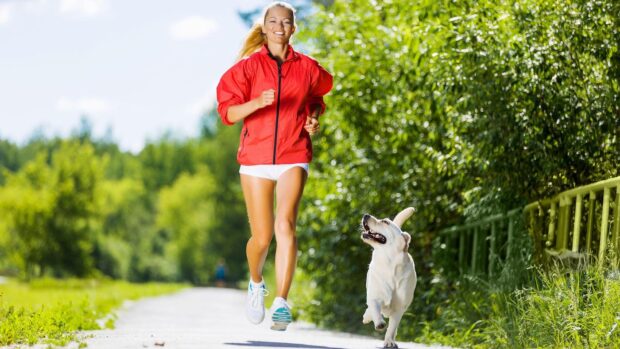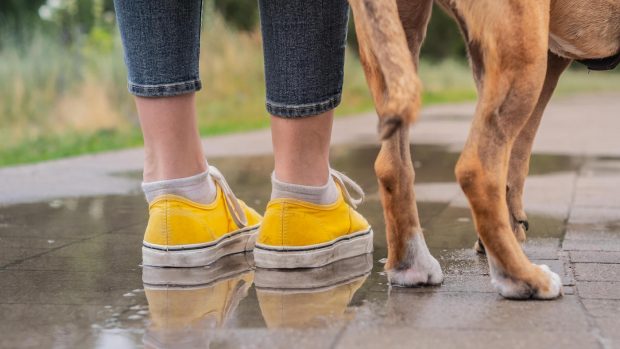A puppy running to greet you and jumping up is cute and playful, but once this puppy is fully grown, bigger and stronger it’s not so cute. It is especially not cute if your dog is jumping up at other people – they might be nervous, unstable on their feet or they might be in clean, smart clothes, but either way this behaviour is not acceptable, so you need to know how to stop your dog jumping up. This training must start from the moment you bring a dog or puppy home, so the behaviour and excitability is not allowed to build up and become learnt or inadvertently rewarded. If you’ve missed this window, you need to be consistent from the moment you decide to stop your dog jumping up.
There is not much that splits opinion in the canine behaviour and training world more than how to stop a dog jumping up and why dogs jump up at you in the first place. While none of the techniques can be classed as wrong or ineffective (unless it’s cruel, of course), some methods are more effective than others, which is because dogs have different personalities and respond to training methods differently, the same as we do.
How to stop a dog jumping up
There are lots of different schools of thought among canine professionals. There are those that say you should just ignore it, those that say you should turn your back on the dog and walk away and then there are those that say you should stand your ground and block it. In severe cases, particularly where young children are involved, it’s sometimes necessary to use a loud noise in order to stop the behaviour and prevent injury to a child. Some suggest that you should make the dog sit and then give treats, but usually they can’t sit as they are too excited, plus a dog’s normal posture is to stand or lay.
This is where the controversy comes in. We are all reward-based behaviourists and trainers, however, throwing a treat only diverts the behaviour rather than stop it. You’re not training the dog not to jump up, you’re just throwing treats to distract and divert – invariably they get the treat, then come back and jump up at you.
How I deal with dogs jumping up
The only methods that are unacceptable are cruel ones, yet many trainers and behaviourists say that by blocking a jump or walking into the dog and standing your ground with no eye contact, you are an adverse method behaviourist or trainer. I disagree. Dogs establish their hierarchy among their litter siblings and groups by moving each other around. They might attempt to invade the personal space of an older dog and be told in no uncertain terms that this is not OK. You can use the same body language to communicate with them – and be aware that they might try to move you around and control your pace, too.
If a person were to come up to you and barge you into you, would you throw them a treat, praise them or stand your ground and say “do you mind”? I would imagine it is very much the latter, but this is frowned upon by some. To stop a dog jumping up, I stand my ground, remove eye contact, and walk forwards and say “off,” then I reward the dog the very moment that all four paws hit the ground – I give my eye contact, smile, say “yes” and give a high value reward.
Another common method is to ignore the dog or turn your back. This will work for some dogs but it is personality dependent – some dogs are relentless. I have seen clients in tears, covered in bruises and bite marks from the dog nipping and jumping up at them as they have tried to ignore it, turn around or walk away and the dog has not relented. In these situations, you must look to other ways in which to stop this behaviour.
The same applies for puppies and dogs on lead. It’s best to be proactive, not reactive. Stop the behaviour before it starts. If the dog is allowed out in front of you on a long loose lead, the first thing they can and will do is jump. This is not because they are naughty or they mean it with malice, but because you’ve not given them guidance and have left to make the dog decision. To add insult to injury, clients will tell the dog off for it, but the behaviour has already happened.
Instead, keep your dog on a short lead – this does not mean a tight lead, but what it keeps your dog beside you. You can then put the lead behind your leg to keep it taught so the dog cannot jump – or for the real kangaroos you can stand on the lead. Then as people approach you, you should already be giving the “off” command and then “yes”. When the interaction is coming to an end you must repeat the “off” command again and then affirm. If the dog complies, affirm, and reward it with eye contact and a high value treat. This way of learning is much more positive and quicker.
Training tips for jumping up
1. Be consistent – find a method you are happy with and that works for you and your dog.
2. Be proactive – stop the behaviour before it starts by pre-empting the situations that you know your dog is going to want to jump up or get over excited.
3. Be firm with others – do not let people stroke your dog until they have all four paws on the ground. Even if they say they don’t mind, it is not OK because after they have had their stroke and been jumped all over, you’re left with the problem that your dog believes that this is the desired behaviour.
4. Avoid eye contact when correcting your dog – this is a mixed signal.
5. Stay rational – we know the dog is deliriously happy to see you and they have to express emotion, but if this makes you melt it leads to a bigger problem moving forward. Try saying “off” the minute you walk in and don’t give no eye contact. If they’re not jumping then engage with them, throw a toy or teach them to roll over for belly rubs.
6. Never punish height seeking jumping. If your dog jumps up at the side of you or at your back (standing on their hindlegs and placing their feet on your legs), they are height seeking or asking for reassurance. This is fear rather than lack of impulse control or attention seeking behaviour, so you need to provide reassurance by placing yourself between your dog and the stimulus causing the problem.
You might also like:

7 reasons that a dog might jump up at you

How to master recall

How to master loose lead walking

How to teach a dog to retrieve

Double the fun: how to run with your dog
Horse & Hound magazine, out every Thursday, is packed with all the latest news and reports, as well as interviews, specials, nostalgia, vet and training advice. Find how you can enjoy the magazine delivered to your door every week, plus options to upgrade your subscription to access our online service that brings you breaking news and reports as well as other benefits.




